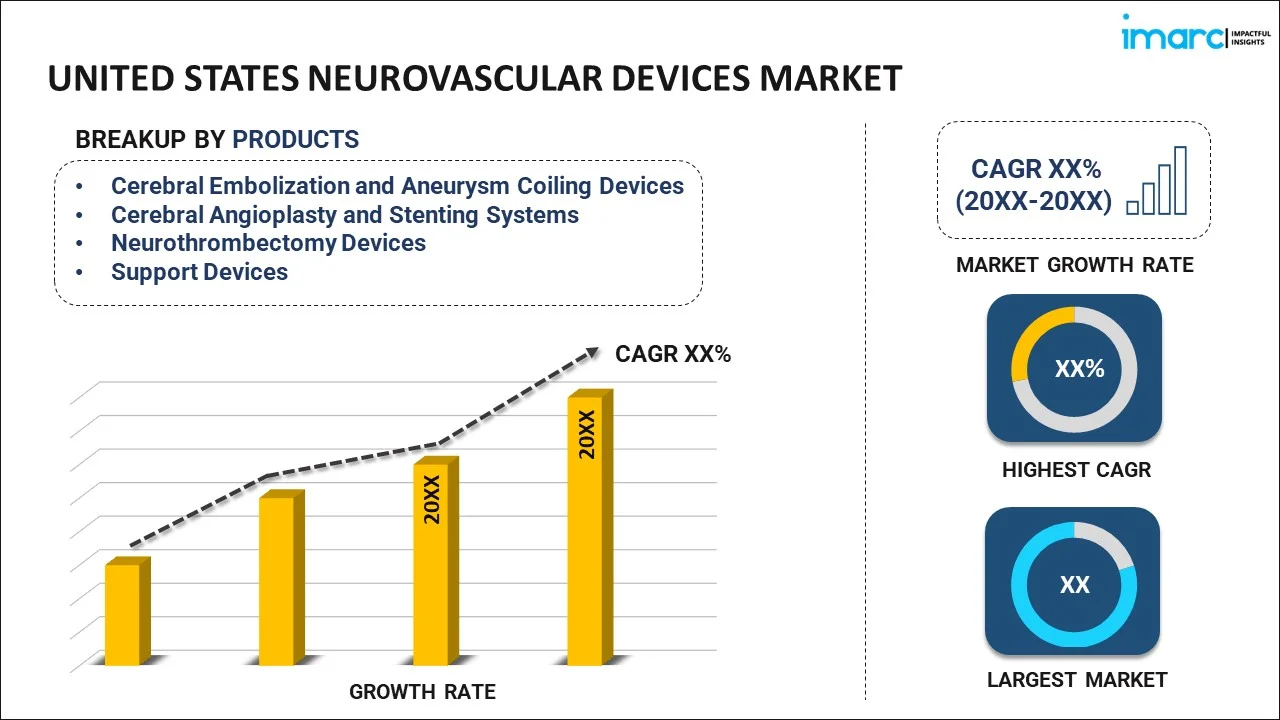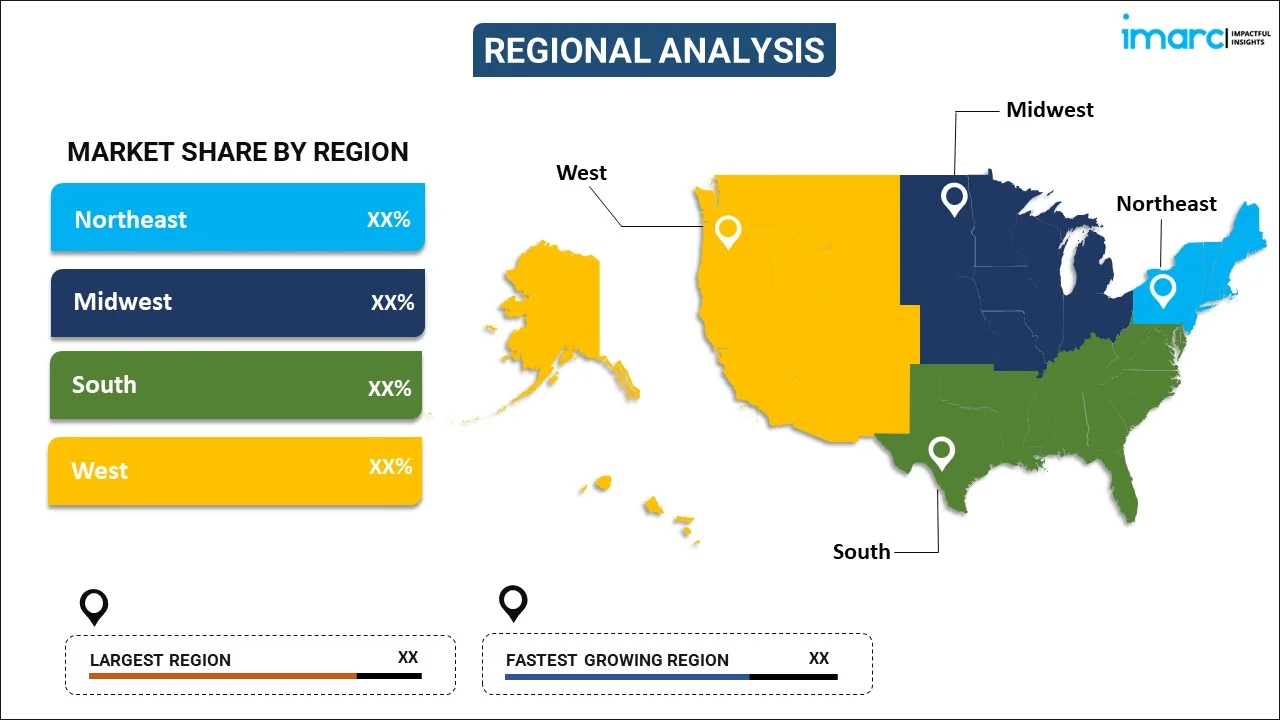
United States Neurovascular Devices Market Report by Product (Cerebral Embolization and Aneurysm Coiling Devices, Cerebral Angioplasty and Stenting Systems, Neurothrombectomy Devices, Support Devices), Application (Ischemic Stroke, Aneurysm, Arteriovenous Malformation and Fistulas (AVM), Stenosis, and Others), End User (Hospitals, Ambulatory Surgical Centers, Clinics, and Others), and Region 2025-2033
Market Overview:
The United States neurovascular devices market size reached USD 1.1 Billion in 2024. Looking forward, IMARC Group expects the market to reach USD 2.4 Billion by 2033, exhibiting a growth rate (CAGR) of 8.7% during 2025-2033. The growing incidence of neurovascular disorders, the development of more effective and minimally invasive neurovascular devices, the growing awareness about neurovascular disorders, and the importance of early diagnosis represent some of the key factors driving the market.
|
Report Attribute
|
Key Statistics
|
|---|---|
|
Base Year
|
2024 |
|
Forecast Years
|
2025-2033
|
|
Historical Years
|
2019-2024
|
| Market Size in 2024 | USD 1.1 Billion |
| Market Forecast in 2033 | USD 2.4 Billion |
| Market Growth Rate (2025-2033) | 8.7% |
Neurovascular devices are a crucial component of modern medical technology, designed to diagnose and treat various conditions affecting the blood vessels in the brain and central nervous system. These devices are employed by healthcare professionals to address several neurovascular disorders, including aneurysms, strokes, and vascular malformations. They include several tools and equipment that aid in the assessment, visualization, and treatment of vascular issues within the brain. For instance, an angiography machine employs advanced imaging techniques to visualize blood vessels in the brain, helping physicians identify abnormalities or blockages which is invaluable in the early detection of conditions such as cerebral aneurysms, allowing timely intervention. Additionally, neurovascular devices are essential in the treatment phase. Also, coils and stents are often used to treat cerebral aneurysms and vascular malformations. Coils are typically manufactured of platinum and inserted into the aneurysm to induce clot formation, preventing further bleeding. Stents are used to reinforce weakened blood vessel walls, maintaining proper blood flow. Additionally, with the evolution of neurovascular devices, minimally invasive techniques, such as endovascular coiling and embolization, have become standard procedures that reduce the risks associated with open surgeries and lead to faster recovery times.
United States Neurovascular Devices Market Trends:
The market is primarily driven by the growing incidence of neurovascular disorders, including strokes, aneurysms, and arteriovenous malformations. It is creating a substantial demand for neurovascular devices that aid in the diagnosis and treatment of these conditions. In addition, several ongoing advancements in medical technology led to the development of more effective and minimally invasive neurovascular devices that improve patient outcomes and reduce the risks associated with traditional surgical procedures, thus contributing to the market growth. Moreover, the shifting patient preferences for minimally invasive (MI) procedures over traditional surgical interventions due to shorter recovery times and reduced complications, represents another major growth-inducing factor. Besides this, the growing geriatric population is susceptible to several neurovascular diseases, which is driving the demand for devices that can address these conditions, thus accelerating the market growth. Along with this, the growing awareness about neurovascular disorders and the importance of early diagnosis resulted in the rising number of individuals seeking medical attention, which is escalating the demand for neurovascular devices for accurate diagnosis and treatment, further propelling the market growth. Apart from this, the growing healthcare expenditure, including the adoption of advanced medical devices, is further driving the neurovascular devices market. Furthermore, the stringent regulatory approvals and safety measures in the United States ensure that neurovascular devices meet high standards of quality and patient safety which provide confidence among healthcare professionals and patients, further creating a positive market outlook.
United States Neurovascular Devices Market Segmentation:
IMARC Group provides an analysis of the key trends in each segment of the market, along with forecasts at the country level for 2025-2033. Our report has categorized the market based on product, application, and end user.
Product Insights:

- Cerebral Embolization and Aneurysm Coiling Devices
- Embolic Coils
- Flow Diverters
- Liquid Embolic Agents
- Cerebral Angioplasty and Stenting Systems
- Carotid Artery Stents
- Embolic Protection Devices
- Neurothrombectomy Devices
- Clot Retrieval Devices
- Suction Devices
- Vascular Snares
- Support Devices
- Micro Catheters
- Micro Guidewires
The report has provided a detailed breakup and analysis of the market based on the product. This includes cerebral embolization and aneurysm coiling devices (embolic coils, flow diverters, and liquid embolic agents), cerebral angioplasty and stenting systems (carotid artery stents and embolic protection devices), neurothrombectomy devices (clot retrieval devices, suction devices, and vascular snares), and support devices (micro catheters and micro guidewires).
Application Insights:
- Ischemic Stroke
- Aneurysm
- Arteriovenous Malformation and Fistulas (AVM)
- Stenosis
- Others
A detailed breakup and analysis of the market based on the application have also been provided in the report. This includes ischemic stroke, aneurysm, arteriovenous malformation and fistulas (AVM), stenosis, and others.
End User Insights:
- Hospitals
- Ambulatory Surgical Centers
- Clinics
- Others
The report has provided a detailed breakup and analysis of the market based on the end user. This includes hospitals, ambulatory surgical centers, clinics, and others.
Regional Insights:

- Northeast
- Midwest
- South
- West
The report has also provided a comprehensive analysis of all the major regional markets, which include Northeast, Midwest, South, and West.
Competitive Landscape:
The market research report has also provided a comprehensive analysis of the competitive landscape. Competitive analysis such as market structure, key player positioning, top winning strategies, competitive dashboard, and company evaluation quadrant has been covered in the report. Also, detailed profiles of all major companies have been provided.
United States Neurovascular Devices Market Report Coverage:
| Report Features | Details |
|---|---|
| Base Year of the Analysis | 2024 |
| Historical Period | 2019-2024 |
| Forecast Period | 2025-2033 |
| Units | Billion USD |
| Scope of the Report | Exploration of Historical and Forecast Trends, Industry Catalysts and Challenges, Segment-Wise Historical and Predictive Market Assessment:
|
| Products Covered |
|
| Applications Covered | Ischemic Stroke, Aneurysm, Arteriovenous Malformation and Fistulas (AVM), Stenosis, Others |
| End Users Covered | Hospitals, Ambulatory Surgical Centers, Clinics, Others |
| Regions Covered | Northeast, Midwest, South, West |
| Customization Scope | 10% Free Customization |
| Post-Sale Analyst Support | 10-12 Weeks |
| Delivery Format | PDF and Excel through Email (We can also provide the editable version of the report in PPT/Word format on special request) |
Key Questions Answered in This Report:
- How has the United States neurovascular devices market performed so far and how will it perform in the coming years?
- What has been the impact of COVID-19 on the United States neurovascular devices market?
- What is the breakup of the United States neurovascular devices market on the basis of product?
- What is the breakup of the United States neurovascular devices market on the basis of application?
- What is the breakup of the United States neurovascular devices market on the basis of end user?
- What are the various stages in the value chain of the United States neurovascular devices market?
- What are the key driving factors and challenges in the United States neurovascular devices?
- What is the structure of the United States neurovascular devices market and who are the key players?
- What is the degree of competition in the United States neurovascular devices market?
Key Benefits for Stakeholders:
- IMARC’s industry report offers a comprehensive quantitative analysis of various market segments, historical and current market trends, market forecasts, and dynamics of the United States neurovascular devices market from 2019-2033.
- The research report provides the latest information on the market drivers, challenges, and opportunities in the United States neurovascular devices market.
- Porter's five forces analysis assist stakeholders in assessing the impact of new entrants, competitive rivalry, supplier power, buyer power, and the threat of substitution. It helps stakeholders to analyze the level of competition within the United States neurovascular devices industry and its attractiveness.
- Competitive landscape allows stakeholders to understand their competitive environment and provides an insight into the current positions of key players in the market.
Need more help?
- Speak to our experienced analysts for insights on the current market scenarios.
- Include additional segments and countries to customize the report as per your requirement.
- Gain an unparalleled competitive advantage in your domain by understanding how to utilize the report and positively impacting your operations and revenue.
- For further assistance, please connect with our analysts.
 Request Customization
Request Customization
 Speak to an Analyst
Speak to an Analyst
 Request Brochure
Request Brochure
 Inquire Before Buying
Inquire Before Buying




.webp)




.webp)












